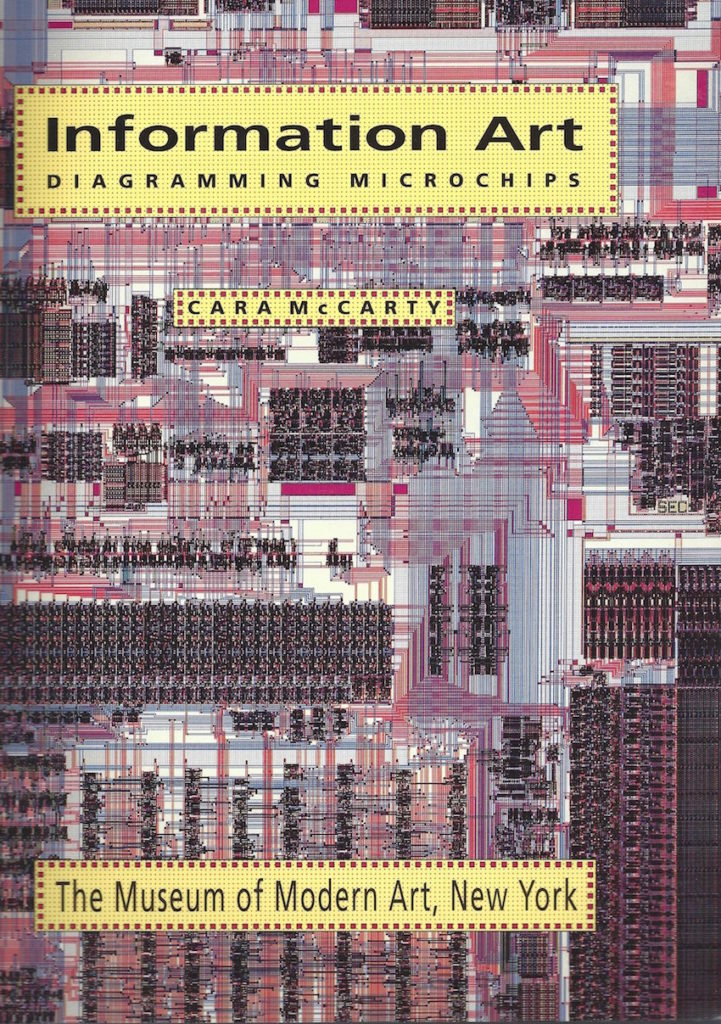
Tecnoestética eletrônica no final do século XX (McCarthy 1990)
McCARTHY, Cara. 1990. Information art: diagramming microchips. New York: The Museum of Modern Art (MoMA).
FORÇAS INVISÍVEIS
The new machine art is visually incomprehensible unless one knows about and believes in the existence of invisible forces. (Arthur Drexler, in: McCarthy 1990:3)
A DESMATERIALIZAÇÃO DE FORMAS SÓLIDAS EM UM AGLOMERADO-FEIXE-MULTIDÃO DE RELAÇÕES LINEARES
Printed circuits in particular, and the use of wires colored for identification in the RAMAC control panel, suggest one change that technology is likely to make on many of our common artifacts: the dematerialization of solid forms into clusters of linear relationships. (Arthur Drexler, in: McCarthy 1990:3)
CONVERGÊNCIA
The integrated circuit is the result of one of those rare, pivotal moments in history when discoveries in all the major sciences – chemistry, physics, mathematics, optics, and electrical engineering – converged, and combined with a culture ready to implement the technology. (McCarthy 1990:4)
PEQUENA LASCA DE SILÍCIO
The focal point of that knowledge is contained within a tiny sliver of silicon known as an integrated circuit, a microchip, or chip, which is layered with patterns of circuits too small for the naked eye to see. (McCarthy 1990:4)
CAMINHOS ELETRÔNICOS
The diagrams reproduced here are computer-generated plots of the electronic pathways that make up integrated circuits. (McCarthy 1990:4)
DIAGRAMA AMPLIADO
Usually we thing of diagrams as being representations smaller than the final product, but these drawings are a few hundred times larger than the actual circuits; and they are so intricate that even when enlarged five hundred times they retain their density. (McCarthy 1990:4)
NÃO É FEITO PARA SER VISTO
These designs were in fact not meant to be seen. (McCarthy 1990:4)
EFICIÊNCIA RIGOROSA
The complex network of lines channel the flow of data, and their configurations determine how it is processed. Unlike painting, which is primarily an emotional and aesthetic endeavor, these are designs of rigorous efficiency guided by rules of logic and laws of physics. (McCarthy 1990:4)
HUMANAMENTE INDECIFRÁVEIS
They are the most complex patterns people have ever made, and because of their intricacy they can be deciphered completely only by a computer. (McCarthy 1990:4)
ÍCONES DE NOSSO TEMPO
They are icons of our time just as mechanical components were of the first part of the twentieth century. (McCarthy 1990:4)
[I]ntegrated circuits are among the most highly designed and exquisitely crafted artifacts of our civilization. (McCarthy 1990:10)
CAD
They [computer scientists] are mapping technology, diagramming electronic circuits whose functions are embedded in the minuscule structures of silicon crystals. Although perceptually the chips are tiny, structurally they are vast and complex; they now consist of ten to twenty-five layers. It is impossible to design at that level and with such density without the aid of a computer. (McCarthy 1990:5)
MINIATURIZAÇÃO
In the machine age bigger was usually better, but in the electronic age the opposite is true. (McCarthy 1990:5)
The compact nature of integrated circuits allows them to operate at high speeds for long periods without failure of components. They work by “on” or “off” pulses of electric current, and the transistor is their basic switching element. (McCarthy 1990:5)
DA GUERRA PARA O COTIDIANO
Integrated circuits have changed from being costly devices for use almost exclusively in space and military equipment to forming the basis of all modern electronics. (McCarthy 1990:6)
EXPECTATIVAS ELETRÔNICAS
Many of the benefits we enjoy and the conveniences we take for granted derive from these tiny devices that are concealed in computer systems and in the products we use every day. As a culture we are predisposed toward speed and efficiency, and microchips have greatly increased our expectations. (McCarthy 1990:6)
MISTÉRIO
Despite their ubiquity there is an element of mystery to integrated circuits. They are mysterious because they are sensorially inaccessible to us. They have no visible moving components, gears, or levers and they are silent, yet they perform operations and calculations at imperceivable speeds. The only movement involves electrons, which equally elude our senses. We press buttons to interact with electronic devices and the results come immediately, but most of us do not have the knowledge to understand how it happened. (McCarthy 1990:6)
CIDADE ELETRÔNICA
They [diagrams] are like multilevel road maps, with the transistors and circuits resembling highways, valleys, rivers, and small back roads. […] Colors and textures distinguish the various circuit layers and the spatial relationships of elements. White areas indicate unused space – territory that is still available for development. (McCarthy 1990:6)
When we let our imaginations roam, the grid patterns of these diagrams resemble the warp and weft structure of woven textiles, aerial views of cities, agricultural fields, paintings, calendars. (McCarthy 1990:6)
Engineers often discuss the design of integrated circuits in terms of real estate. Their concerns are those of a developer: crowding, density, economy, and efficiency. Like developers, they want to optimize the use of space, fitting more and more into smaller areas. (McCarthy 1990:6)
The change in character from the early plots to the more recent ones resembles the change from ranch house to high-rise, from suburban sprawl to city. Initially, silicon is like a vacant lot. Since the earliest integrated circuits had few components, their configurations spread out much like a ranch house. Today the dense compositions are built up in planes with several layers consisting of detailed patterns of tens of thousands of transistors and circuit structures. (McCarthy 1990:9)
A GRADE
The grid is a form we can understand, for it has been used for centuries by many civilizations as a compositional device to impose order, discipline, and structural clarity. (McCarthy 1990:6)
AREIA
Integrated circuits begin as tiny pieces of sand. (McCarthy 1990:9)
SEMICONDUTORES e CONTROLE ELETRÔNICO
In its pure form silicon conducts very little electricity, but by altering its state with the addition of minute amounts of other materials, it becomes a semiconductor. In other words, it can function as either an insulator or a conductor of electricity and is therefore an excellent material to use for structuring pathways to control the flow of electricity. (McCarthy 1990:9)
CONTROLE ATÔMICO
The development of integrated circuits depends on our ability to control and manipulate the atomic structure of materials. (McCarthy 1990:9)
Even the tiniest dust particle, smaller than the eye can detect, can disrupt the delicate patterns being constructed on the wafer. (McCarthy 1990:10)
PISTAS INTUITIVAS
They [microchips] are objects of wonderment, and the diagrams illustrated here bring to life their concealed beauty. Although not designed for aesthetic appeal, the diagrams are beautiful and powerful images in their own right […]. The diagrams are […] paradigms of technology, and their complex network of lines provide intuitive clues to the precision and efficiency we have come to associate with microelectronics. (McCarthy 1990:10)





 O LaSPA é sediado no Instituto de Filosofia e Ciências Humanas (
O LaSPA é sediado no Instituto de Filosofia e Ciências Humanas (